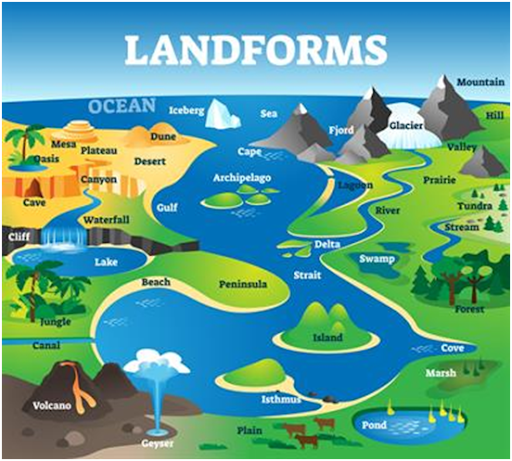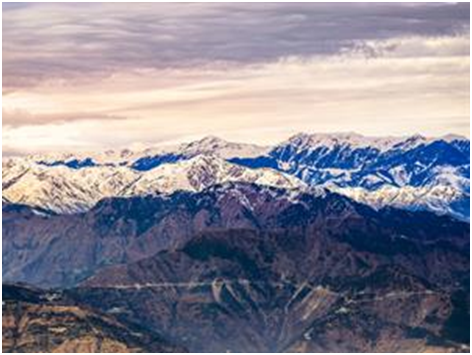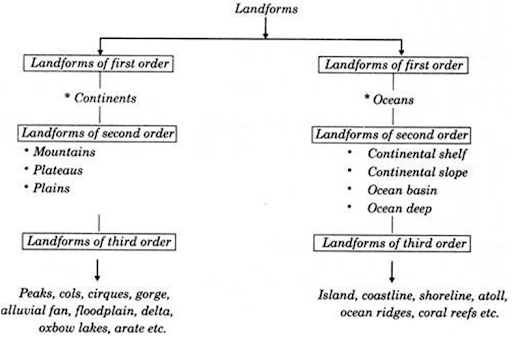A landform is a feature on the Earth’s
surface that is part of the terrain.
Mountains, hills, plateaus,
and plains are the four major types of landforms. Minor landforms
include buttes, canyons, valleys, and basins.
Tectonic plate movement under the Earth can
create landforms by pushing up mountains and hills. Erosion by water
and wind can wear down land and create landforms like valleys and canyons. Both
processes happen over a long period of time, sometimes millions of years.
Classification of landforms:
In terms of origin, oceans and continents have
certain differences. Generally, the materials which constitute the ocean bottom
are harder and heavier than those which constitute the continents. Though the
interior of the earth is still in a hot and molten state, it is still
undergoing contraction.
The contractions could be slow or sudden.
Whether slow or sudden, the contractions are continuously altering the form of
the earth’s surface. Such changes on the earth’s surface are therefore caused
by the actions of internal force.
Since the very beginning of the earth, its
surface has been continuously subjected to change by the action of river,
glaciers, winds, sea waves, earthquakes, etc. Such changes are, therefore,
caused by the actions of external force.
|
First-order landforms |
Second-order landforms |
Third-order landforms |
|
|
|
First order, second order and third order
landforms
- Landforms of
First Order: By the actions of internal forces anticlines and
synclines were formed and in course of time these have been identified as
continents and oceans. That is why, they are called as Landforms
of First Order or Primary landforms.
The continental landforms consist of Americas,
Eurasia, Africa, Australia and Antarctica. The total area is nearly 148 million
sq km, i.e., 28 per cent of the earth’s surface and average height is 830
metres.
- First order landforms: Continents and oceans.
- Continents are the huge land masses on
Earth.
- Huge water bodies are called Oceans.
- Landforms of
Second Order:
The plateaus, mountains, plains and extensive
deserts of the continents are the example of the landforms of second order on
the continents.
Examples of second order Landforms
(a) Mountains
(b) Plateaus
(c) Plains
1.
Mountains
· Made of steep slopes
· They are found as individual or in groups.
Peak: The highest point of a mountain.
|
Mountain
Range |
Continent |
|
Himalaya |
Asia |
|
Rocky Mountains |
North America |
|
Andes |
South America |
The longest mountain range in the world: The Andes (7,000 km)
The highest peak in the world: Mt. Everest (8,848 m)
· December 11 is noted as the
International Mountain Day.
· Hill Stations in Tamil Nadu: Udhagamandalam, Kodaikanal, Kolli hills, Yercaud and Yelagiri.
Flat and relatively low-lying lands.
· Usually less than 200 meters above sea level.
|
Civilisation |
River |
Country |
|
Indus |
Indus |
India |
|
Nile
valley |
Nile |
Egypt |
|
Mesopotamian |
Tigris–Euphrates |
West
Asia |
Important plains in Tamil
Nadu: Cauvery and Vaigai.
Important!
Indo-Gangetic plain is one of the largest plains in the world.
Coastal plains: Low lying lands adjacent to oceans and seas
- Landform of
Third Order:
These landforms are formed as a result of erosional and depositional
activities of rivers, glaciers, winds, and waves on mountains, plateaus, and
plains.
Various features which are generally smaller
parts of second order landforms or which form on the second order landforms are
known as landforms of third order. There are innumerable such landforms over
the continents and at the sea floor.
Example: Valleys, beaches and sand dunes
The
process of removal of surface material from the Earth's crust is known as erosion.
The
transportation and deposition of eroded materials on the low lying areas is
known as deposition.
Peaks, cols, cirques, gorge, morains, alluvial fans, floodplains, ox-bow lakes, levees, deltas, ocean islands, volcanoes and ridges are some of the many features of third order landforms.
Smallest continent: Australia










